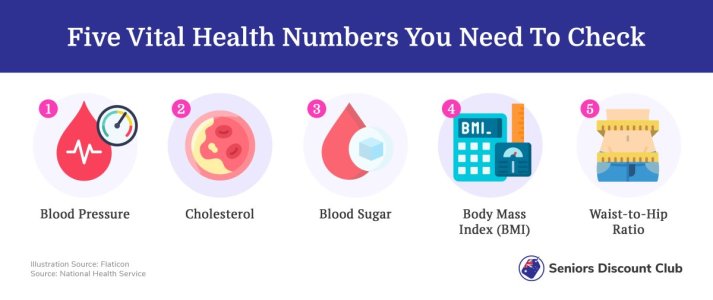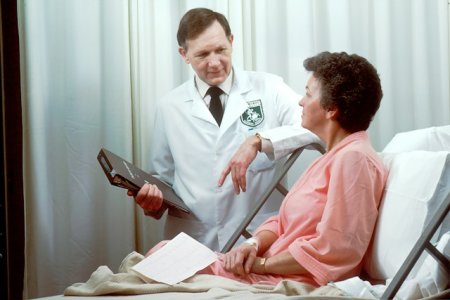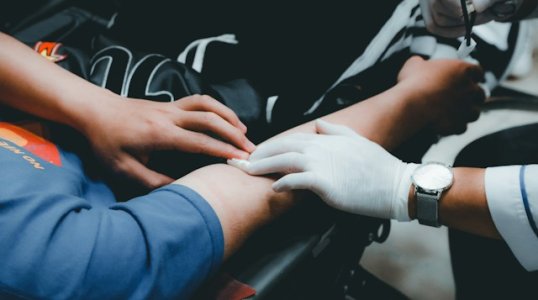Discover the 5 vital health numbers to live a healthier life
By
Seia Ibanez
- Replies 0
Disclaimer: This article should not be taken as medical advice. Readers are recommended to consult their GPs before undergoing these tests.
In the realm of health and wellness, several metrics can be used to gauge one's health status.
From the number of steps walked to the amount of calories burned and even the quantity of fruits and vegetables consumed daily, these figures can provide a snapshot of your overall health.
However, amidst this sea of numbers, five crucial health measurements stand out.
These are the figures that doctors wish every patient knew and monitored regularly—blood pressure, blood sugar, Body Mass Index (BMI), hip-to-waist ratio, and cholesterol levels.
Keeping these five numbers in check could be the difference between ageing healthily and facing serious health complications.
1. Blood Pressure
High blood pressure, also known as hypertension, is often referred to as the 'silent killer'.
This is because it often presents no symptoms, yet it can put extra strain on your blood vessels, heart, kidneys, brain, and eyes, significantly increasing the risk of heart attacks or strokes, according to the United Kingdom's National Health Service (NHS).
Blood pressure is measured in millimetres of mercury (mmHg) and is presented as two numbers—systolic and diastolic.
The systolic number, the top one, refers to the pressure when the heart pushes blood out and around the body.
Diastolic, the bottom number, is the pressure when the heart rests between beats. A normal reading is between 90/60mmHg and 120/80mmHg.
Anything above 140/80mmHg is technically considered high, while below 89/59mmHg is labelled as low.
Readings between 121/81mmHg and 139/89mmHg may lead to hypertension, but this can be controlled by cutting back on salt, losing weight, exercising regularly, drinking less caffeine, and quitting or avoiding smoking.
Our member @Babybird also recommended some foods to eat to help balance our blood pressure naturally. You can learn more about it here.
The UK NHS also noted that every person’s blood pressure is different, and what may be considered low or high for one may be normal for another.
2. Cholesterol
Cholesterol, a fatty, waxy substance, can build up in the blood and lead to blocked vessels, putting you at risk of heart problems.
According to the Heart Research Institute, high cholesterol usually stems from eating too much fatty food, smoking, drinking alcohol, not exercising enough, and being overweight.
Your total cholesterol shouldn't be higher than 5mmoI/L. High-density lipoprotein (HDL) cholesterol, known as the 'good' type, should be 1mmoI/L or above for men and at least 1.2mmoI/L for women.
Non-HDL cholesterol—the 'bad' type—should be 4mmoI/L or below.
Similar to high blood pressure, having high cholesterol can be difficult to spot.
But in rare cases, high cholesterol can trigger white rings around the cornea–the clear outer layer at the front of the eye—or a yellow or orange growth on the skin.
That’s why it’s important to do a blood test to check your cholesterol. If you’re worried about getting one, you can do five tips to prepare yourself for getting a blood test.
These preparation strategies can help you get through the procedure, but it’s also highly recommended to visit your GP before doing a blood test. You can read more about it here.
3. Blood Sugar
High blood sugar levels could indicate type 2 diabetes.
According to Diabetes Australia, common symptoms of type 2 diabetes include being thirsty, urinating a lot, tiredness and blurred vision. In Australia, over 1.5 million people are living with diabetes.
High blood sugar occurs when the body does not produce enough insulin or the cell bodies don’t react properly to the hormone.
A simple blood test that checks glucose levels is used to spot pre-diabetes and type 2 diabetes among those with symptoms.
The most accurate test is the Hba1C (Glycosylated Haemoglobin) test, which calculates the average blood glucose over three months.
A normal Hba1C score, which calculates the average blood glucose over three months, is considered to be below 42mmol/mol. If it is over 48mmol/mol, it could mean you have diabetes.
On the other hand, the UK NHS said low blood sugar affects diabetes patients taking insulin or medication. In severe cases, people may become unconscious.
To manage your blood sugar levels, it is recommended to have a healthy diet. For type 2 diabetes patients, it is recommended that they keep their sugar, fat, and salt to a minimum.
4. Body Mass Index (BMI)
Body Mass Index (BMI) is a widely used method to check if you're a healthy weight.
According to data, two-thirds of Australian adults are living with obesity or being overweight.
According to the UK NHS, ‘The BMI is calculated by dividing an adult's weight in kilograms by their height in metres squared.’
'For example, if you weigh 70kg and are 1.73m tall, you work out your BMI by:
Squaring your height in metres: 1.73 x 1.73 = 2.99
Dividing your weight in kilograms: 70 ÷ 2.99 = 23.41
'Your result will be displayed to one decimal place, for example, 23.4.'
A BMI of 18.5 is underweight, 18.5 to 24.9 is a healthy weight, 25 to 29.9 is overweight, and 30 and above is obese.
5. Waist-to-Hip Ratio
Aside from keeping track of your BMI, doctors said keeping your weight in check also means checking the shape of your body and where it stores fat.
The waist-to-hip ratio is a lesser-known alternative to BMI.
It is calculated by measuring the circumference of the waist and comparing it to the circumference of your hips.
The higher the ratio, the more fat is stored around your waist or abdomen, often called 'apple shape'.
According to research conducted by the Institute of Preventative Medicine in Copenhagen, this fat distribution poses a greater risk of health problems than fat stored around the hips, known as a ‘pear shape’.
To check your ratio, you only need a tape measure.
Measure the hips at the widest point around the buttocks and measure the waist just above the belly button.
Once you have the measurements, divide the waist measurement by the hip measurement.
The UK NHS classes high risk as a ratio above 0.90 for men and 0.85 for women.
Here is the summarised list of the vital health numbers you need to check:

Remember, these numbers are not just figures on a chart. They're indicators of your health and well-being.
By keeping track of these numbers, you're taking a proactive step towards a healthier, happier life.

Have you been monitoring your vital health numbers? Let us know in the comments below.
In the realm of health and wellness, several metrics can be used to gauge one's health status.
From the number of steps walked to the amount of calories burned and even the quantity of fruits and vegetables consumed daily, these figures can provide a snapshot of your overall health.
However, amidst this sea of numbers, five crucial health measurements stand out.
These are the figures that doctors wish every patient knew and monitored regularly—blood pressure, blood sugar, Body Mass Index (BMI), hip-to-waist ratio, and cholesterol levels.
Keeping these five numbers in check could be the difference between ageing healthily and facing serious health complications.
1. Blood Pressure
High blood pressure, also known as hypertension, is often referred to as the 'silent killer'.
This is because it often presents no symptoms, yet it can put extra strain on your blood vessels, heart, kidneys, brain, and eyes, significantly increasing the risk of heart attacks or strokes, according to the United Kingdom's National Health Service (NHS).
Blood pressure is measured in millimetres of mercury (mmHg) and is presented as two numbers—systolic and diastolic.
The systolic number, the top one, refers to the pressure when the heart pushes blood out and around the body.
Diastolic, the bottom number, is the pressure when the heart rests between beats. A normal reading is between 90/60mmHg and 120/80mmHg.
Anything above 140/80mmHg is technically considered high, while below 89/59mmHg is labelled as low.
Readings between 121/81mmHg and 139/89mmHg may lead to hypertension, but this can be controlled by cutting back on salt, losing weight, exercising regularly, drinking less caffeine, and quitting or avoiding smoking.
Our member @Babybird also recommended some foods to eat to help balance our blood pressure naturally. You can learn more about it here.
The UK NHS also noted that every person’s blood pressure is different, and what may be considered low or high for one may be normal for another.
2. Cholesterol
Cholesterol, a fatty, waxy substance, can build up in the blood and lead to blocked vessels, putting you at risk of heart problems.
According to the Heart Research Institute, high cholesterol usually stems from eating too much fatty food, smoking, drinking alcohol, not exercising enough, and being overweight.
Your total cholesterol shouldn't be higher than 5mmoI/L. High-density lipoprotein (HDL) cholesterol, known as the 'good' type, should be 1mmoI/L or above for men and at least 1.2mmoI/L for women.
Non-HDL cholesterol—the 'bad' type—should be 4mmoI/L or below.
Similar to high blood pressure, having high cholesterol can be difficult to spot.
But in rare cases, high cholesterol can trigger white rings around the cornea–the clear outer layer at the front of the eye—or a yellow or orange growth on the skin.
That’s why it’s important to do a blood test to check your cholesterol. If you’re worried about getting one, you can do five tips to prepare yourself for getting a blood test.
These preparation strategies can help you get through the procedure, but it’s also highly recommended to visit your GP before doing a blood test. You can read more about it here.
3. Blood Sugar
High blood sugar levels could indicate type 2 diabetes.
According to Diabetes Australia, common symptoms of type 2 diabetes include being thirsty, urinating a lot, tiredness and blurred vision. In Australia, over 1.5 million people are living with diabetes.
High blood sugar occurs when the body does not produce enough insulin or the cell bodies don’t react properly to the hormone.
A simple blood test that checks glucose levels is used to spot pre-diabetes and type 2 diabetes among those with symptoms.
The most accurate test is the Hba1C (Glycosylated Haemoglobin) test, which calculates the average blood glucose over three months.
A normal Hba1C score, which calculates the average blood glucose over three months, is considered to be below 42mmol/mol. If it is over 48mmol/mol, it could mean you have diabetes.
On the other hand, the UK NHS said low blood sugar affects diabetes patients taking insulin or medication. In severe cases, people may become unconscious.
To manage your blood sugar levels, it is recommended to have a healthy diet. For type 2 diabetes patients, it is recommended that they keep their sugar, fat, and salt to a minimum.
4. Body Mass Index (BMI)
Body Mass Index (BMI) is a widely used method to check if you're a healthy weight.
According to data, two-thirds of Australian adults are living with obesity or being overweight.
According to the UK NHS, ‘The BMI is calculated by dividing an adult's weight in kilograms by their height in metres squared.’
'For example, if you weigh 70kg and are 1.73m tall, you work out your BMI by:
Squaring your height in metres: 1.73 x 1.73 = 2.99
Dividing your weight in kilograms: 70 ÷ 2.99 = 23.41
'Your result will be displayed to one decimal place, for example, 23.4.'
A BMI of 18.5 is underweight, 18.5 to 24.9 is a healthy weight, 25 to 29.9 is overweight, and 30 and above is obese.
5. Waist-to-Hip Ratio
Aside from keeping track of your BMI, doctors said keeping your weight in check also means checking the shape of your body and where it stores fat.
The waist-to-hip ratio is a lesser-known alternative to BMI.
It is calculated by measuring the circumference of the waist and comparing it to the circumference of your hips.
The higher the ratio, the more fat is stored around your waist or abdomen, often called 'apple shape'.
According to research conducted by the Institute of Preventative Medicine in Copenhagen, this fat distribution poses a greater risk of health problems than fat stored around the hips, known as a ‘pear shape’.
To check your ratio, you only need a tape measure.
Measure the hips at the widest point around the buttocks and measure the waist just above the belly button.
Once you have the measurements, divide the waist measurement by the hip measurement.
The UK NHS classes high risk as a ratio above 0.90 for men and 0.85 for women.
Here is the summarised list of the vital health numbers you need to check:

Remember, these numbers are not just figures on a chart. They're indicators of your health and well-being.
By keeping track of these numbers, you're taking a proactive step towards a healthier, happier life.
Key Takeaways
- Monitoring key health numbers can be crucial in preventing serious health issues such as heart attacks or diabetes.
- Vital health measurements include blood pressure, cholesterol levels, blood sugar levels, BMI (Body Mass Index), and waist-to-hip ratio.
- High blood pressure (above 120/80mmHg) and high cholesterol (above 5mmoI/L for total cholesterol) are risk factors for heart disease and other health problems.
- A normal HbA1C score (used to diagnose type 2 diabetes) should be below 42mmol/mol, and maintaining a healthy BMI (between 18.5 and 24.9) is essential for overall health.
Last edited:









